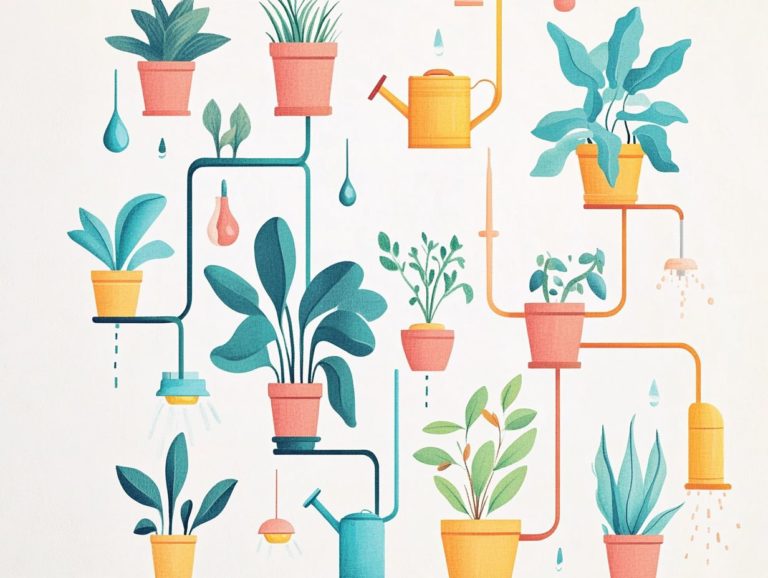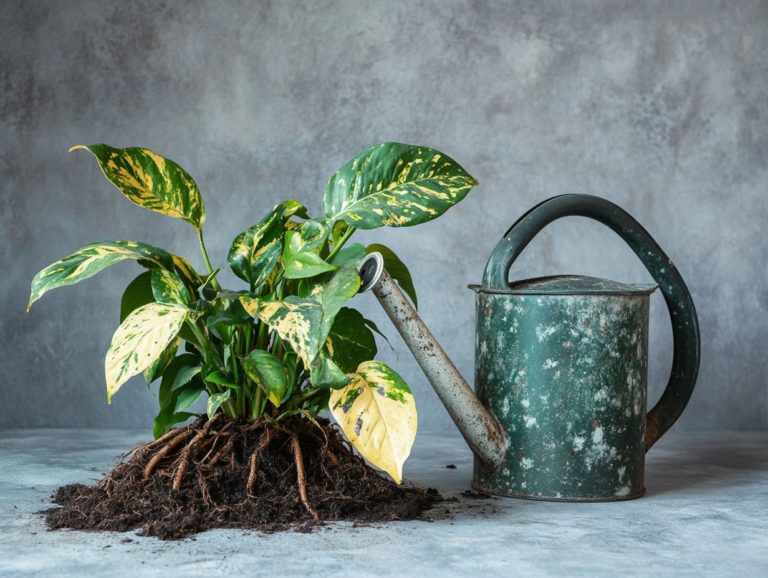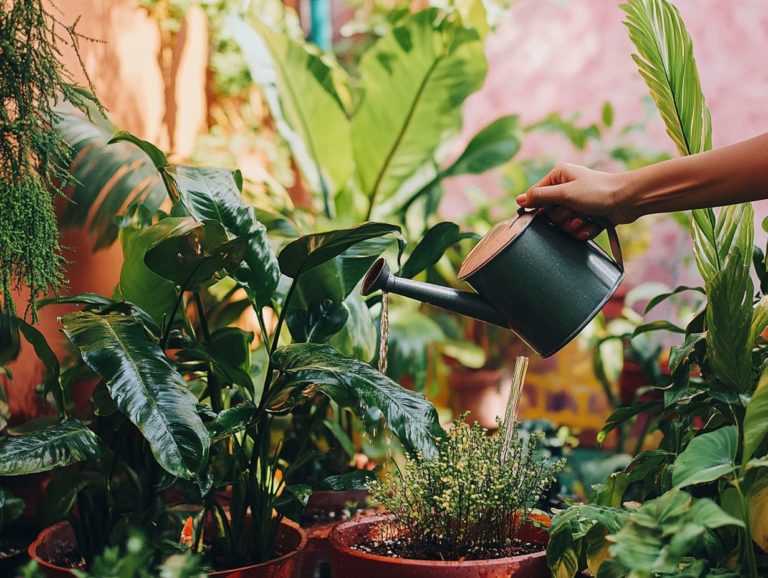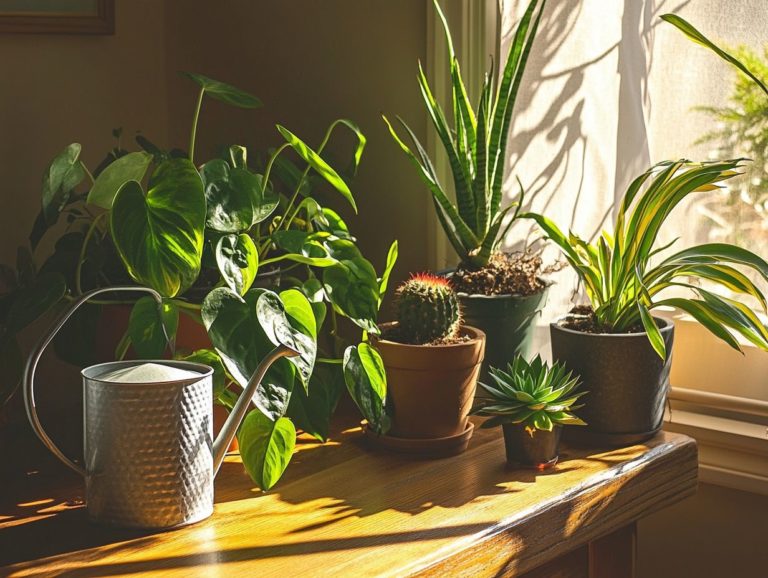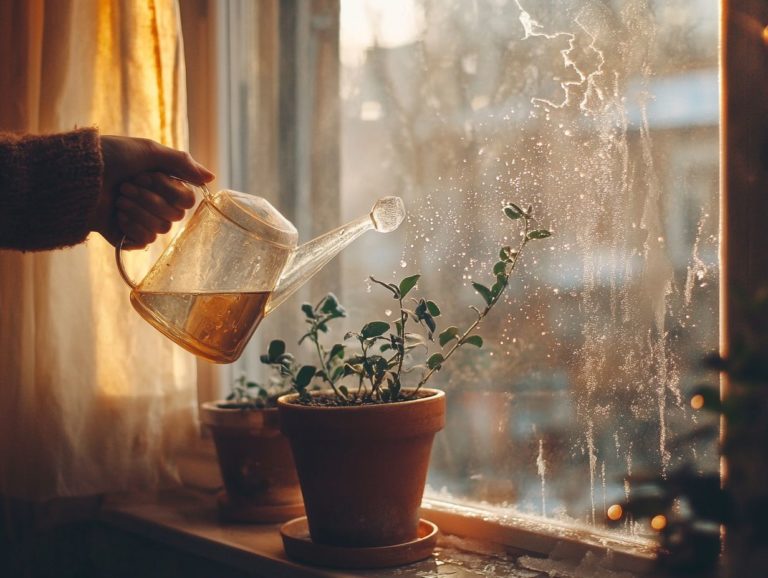How Often Should You Water Indoor Plants?
Indoor plants have the remarkable ability to transform your space. However, nurturing them goes far beyond simply choosing a stylish pot and understanding their specific watering needs.
Understanding how to water your plants properly can be a game changer for their growth and vitality. This article delves into the essential role water plays in plant care, the factors that determine how frequently you should water, and the signs that reveal whether your indoor plants are thirsty or drowning in moisture.
With practical tips and seasonal adjustments at your disposal, you can establish the perfect watering routine for your green companions.
Explore the secrets to cultivating thriving indoor plants!
Contents
- Key Takeaways:
- Importance of Watering Indoor Plants
- Factors Affecting Watering Frequency
- Signs of Underwatering and Overwatering
- General Guidelines for Watering Indoor Plants
- Best Practices for Watering
- Adjusting Watering Schedule for Different Seasons
- Frequently Asked Questions
- How often should you water indoor plants?
- What are some signs that indoor plants need to be watered?
- How can you determine the right amount of water for indoor plants?
- Do indoor plants require less water during winter?
- Can you water indoor plants from the top or bottom?
- Is it better to water indoor plants in the morning or at night?
Key Takeaways:
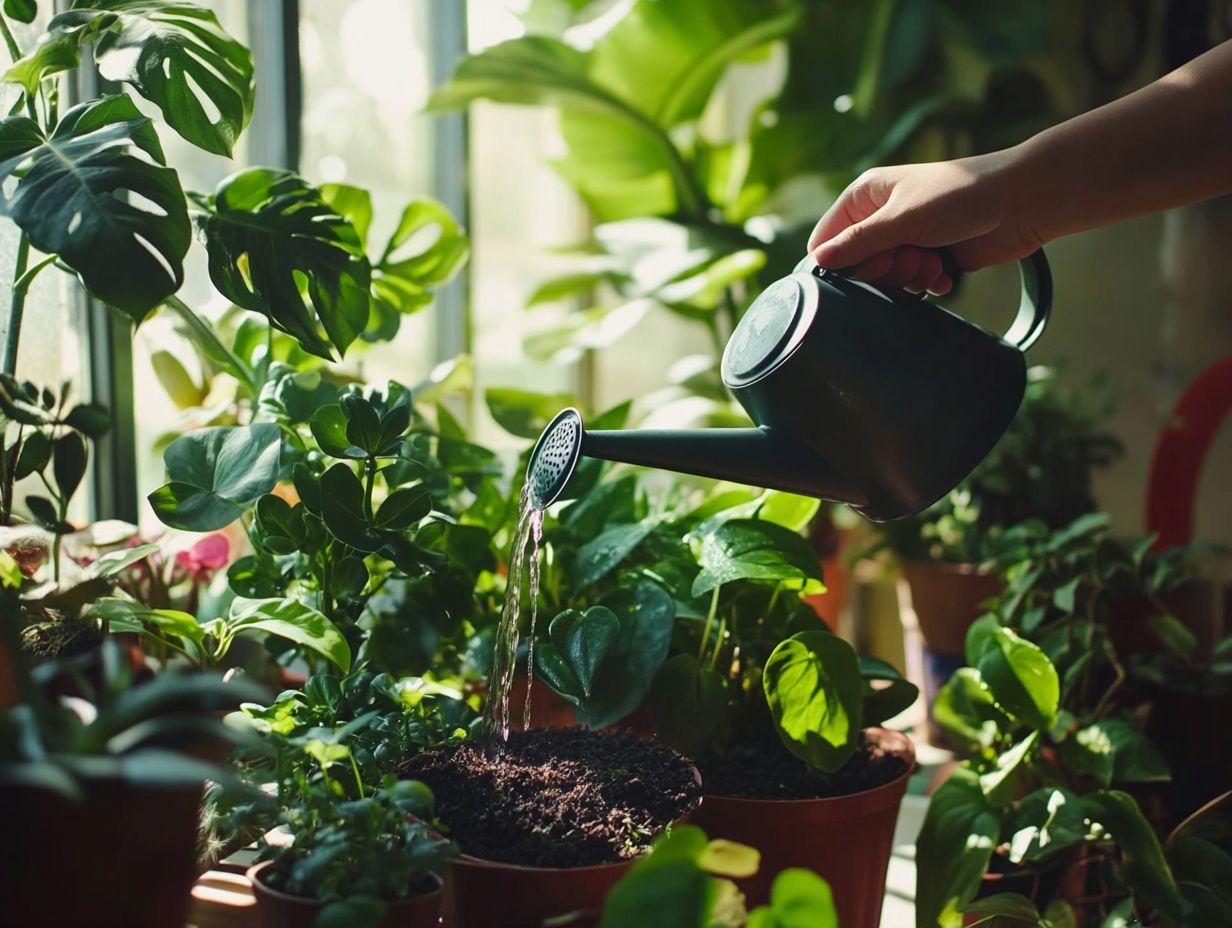
- Proper watering is crucial for the growth and health of indoor plants, as water plays a vital role in meeting their diverse water needs.
- The watering frequency for indoor plants depends on factors such as plant type, environment, size, and location.
- Underwatering and overwatering can be identified through signs and should be addressed promptly to keep indoor plants healthy.
Importance of Watering Indoor Plants
Watering your indoor plants is essential for fostering healthy growth. It directly impacts their water needs, soil moisture, and overall vitality.
Without adequate watering practices, even the hardiest of houseplants think Peace Lilies and Snake Plants can struggle to thrive. They may show distress through wilting or yellowing leaves.
Mastering proper watering techniques nurtures the roots and wards off problems like overwatering. This can be particularly detrimental for sensitive types like orchids and succulents. Understanding effective watering is crucial for every indoor gardener, no matter where they are on their gardening journey.
Role of Water in Plant Growth
Water is essential for plant growth. It serves as a solvent for nutrients and a medium for the process plants use to make their food both crucial for nurturing healthy houseplants.
This vital resource dissolves essential minerals in the soil, making them readily available to the plant roots. It also keeps the cells within the leaves firm and lively.
Maintaining adequate hydration significantly boosts the efficiency of photosynthesis. This enhances energy production that drives overall growth.
When water is in short supply, plants can experience stress. This leads to stunted development and diminished vitality. By grasping the importance of optimal moisture levels, you can elevate your plant care game, ensuring your indoor environment fosters thriving greenery and vibrant foliage.
Factors Affecting Watering Frequency
Several factors influence how often you should water your indoor plants. These include the type of plant, its size, and the surrounding environmental conditions like light exposure and humidity levels.
For example, succulents and cacti have distinct watering needs compared to tropical plants such as Monstera deliciosa and Aglaonema. It s essential to assess these factors carefully to establish an effective watering schedule, which may shift with the changing seasons.
By creating a well-planned watering routine, you not only meet the specific needs of your diverse plant collection but also promote optimal growth and health.
Type of Plant and Environment
The type of plant you choose and its environment play a crucial role in determining the right watering frequency. Each species comes with its own unique water needs and preferences.
Take succulents and cacti, for instance. They thrive in arid conditions, requiring less frequent watering and often favoring drier soil between soakings.
On the flip side, tropical plants like ferns and peace lilies flourish in humid settings. They demand a more regular watering schedule to keep their moisture levels in check.
The amount of natural light your plant receives also influences its watering needs. Plants basking in bright, indirect sunlight may dry out more quickly than those residing in low-light areas. Understanding the nuances of each plant s environment is essential for creating a personalized watering regimen that fosters optimal growth.
Now is the perfect time to assess your watering routine and ensure your plants are thriving!
Size and Location of Plant
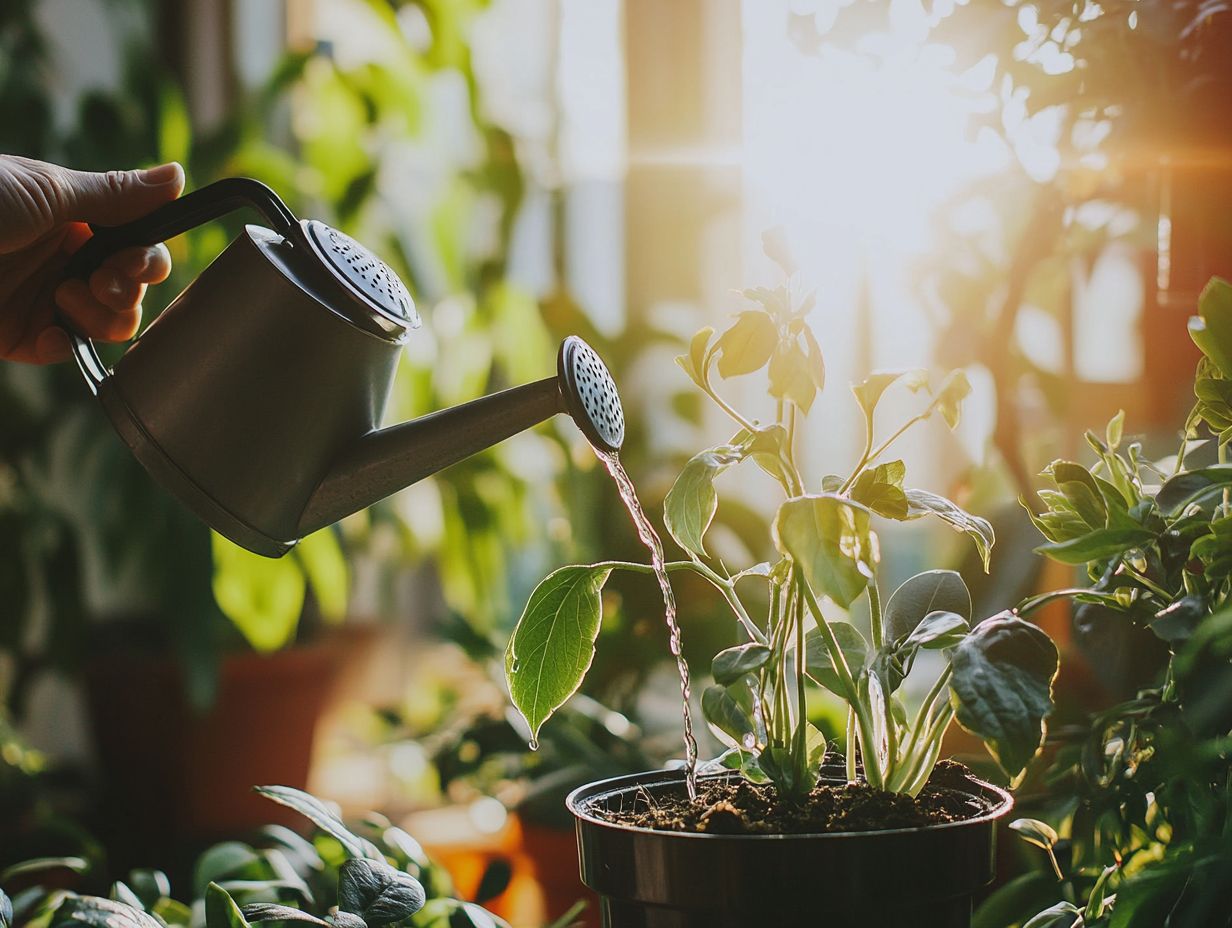
The size and location of your indoor plants are essential indicators of their watering needs. Larger plants typically require more water than their smaller counterparts. Their positioning can greatly influence how well moisture is retained.
For example, if you place a plant in a bright, sunny spot, it may dry out more quickly than one tucked away in a shaded corner. This means you’ll need to water it more often. The size of the pot also plays a critical role; smaller pots can limit the soil’s ability to hold moisture, leading to quicker evaporation.
Make sure your pots have drainage holes. These holes allow excess water to escape, preventing root rot and keeping the soil properly aerated. Actively managing these factors will ensure your plants thrive!
By optimizing your watering routine, you promote the overall health of your plants, making it easier for you to cultivate a thriving indoor garden.
Signs of Underwatering and Overwatering
Recognizing the signs of underwatering and overwatering is crucial for maintaining the health of your indoor plants. Both conditions can negatively impact their growth and vitality.
If you notice symptoms like wilting, browning edges, or yellowing leaves, these could mean the plant needs more water. On the flip side, mushy stems, root rot, or unpleasant odors are often telltale signs of overwatering.
To achieve the perfect balance, consider using a moisture meter, a tool that measures the moisture level in the soil, to accurately assess soil moisture levels. This ensures your plants receive the precise amount of water tailored to their specific needs.
Identifying and Addressing Watering Issues
Identifying and addressing watering issues in your houseplants is crucial for successful plant care. Symptoms can vary widely among different species.
Take the Ficus benjamina, often referred to as the weeping fig. If it’s underwatered, you might notice it shedding leaves. Overwatering could result in yellowing leaves and root rot.
To keep your plants thriving, pay close attention to their foliage, soil moisture, and overall vigor. Investing in moisture meters can provide precise readings of soil conditions. This allows you to adjust your watering practices to meet each plant’s specific needs.
If you notice brown edges on your Ficus leaves, it’s time to rethink your watering schedule!
General Guidelines for Watering Indoor Plants
Establishing general guidelines for watering your indoor plants is essential for effective care. It s important to consider both the frequency of watering and the specific amount of water suited for each type of plant you have.
This thoughtful approach ensures that your plants thrive and flourish in their indoor environment.
Frequency and Amount of Water
Determining the right watering frequency and amount is essential for the health of your plants. These needs can vary significantly with seasonal changes and growth signs.
For instance, during the warmer months, many of your indoor plants may enter a phase of active growth. This typically means they require more frequent watering. To ensure optimal care, consider exploring the best watering techniques for indoor plants. On the flip side, plants like portulaca and succulents thrive in drier conditions and might only need a drink every two to three weeks.
As cooler weather approaches, it’s crucial to adjust your watering schedule to prevent root rot, particularly for moisture-loving plants such as ferns. Keep a close eye on the top inch of soil; if it feels dry, that s your cue to water.
Drooping leaves might indicate they re thirsty, while yellowing leaves could suggest they’ve had too much to drink. Making these adjustments based on your plants signals will help ensure they grow optimally and remain vibrant.
Start adjusting your watering habits today by learning about watering frequency and watch your indoor garden flourish!
Best Practices for Watering
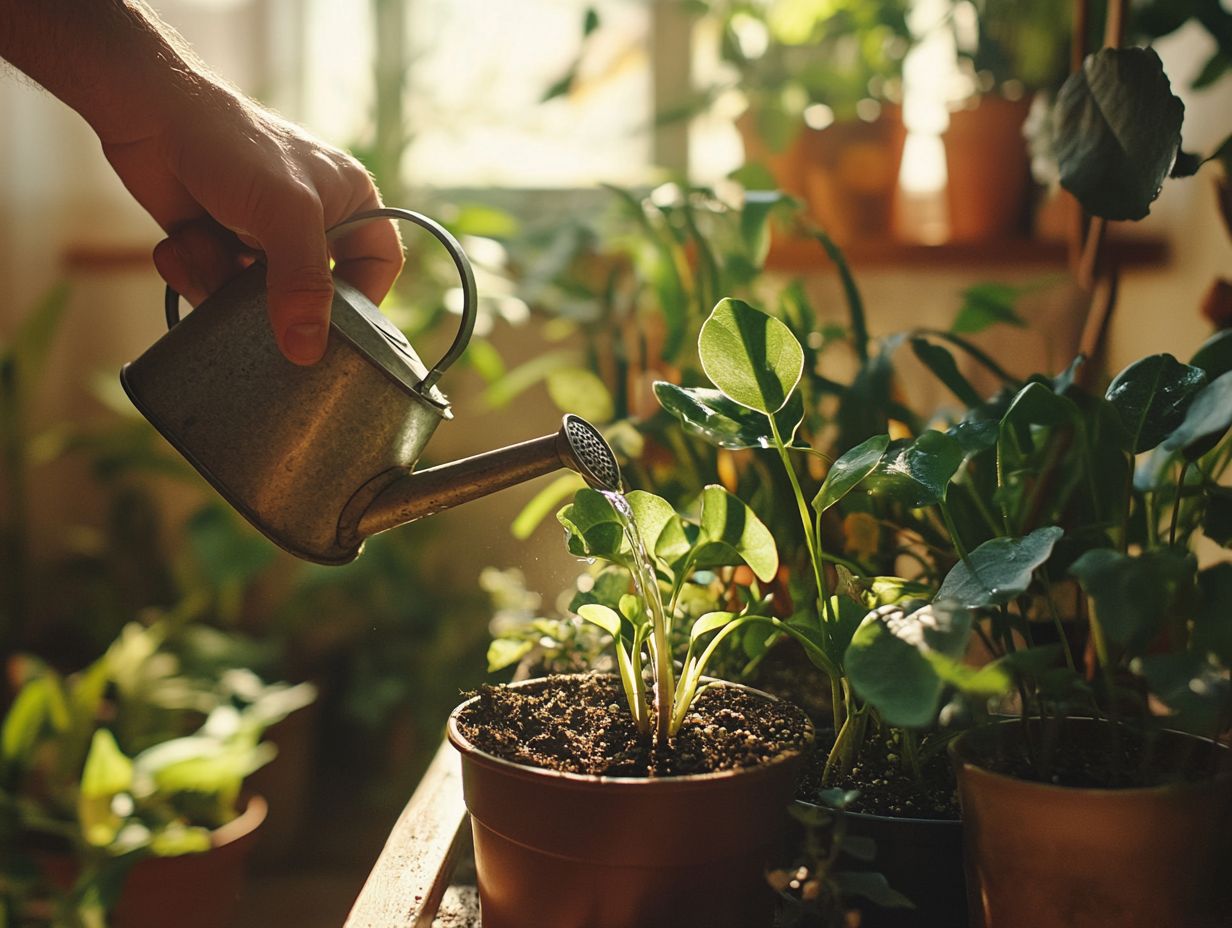
Employing best practices for watering your indoor plants can significantly enhance their health and longevity. Focus on effective watering techniques that take drainage holes and water quality into account.
By paying attention to each plant’s specific needs, you can create the best conditions for robust growth. Regularly checking soil moisture is vital, as overwatering can be just as harmful as letting them dry out. A simple fingertip test can easily reveal the moisture level, guiding your decision on whether to water or hold off. Opting for filtered or room temperature water minimizes harmful chemicals, ensuring your plants receive the finest hydration. Understanding the science of watering indoor plants can also enhance your watering techniques for healthier growth.
This mindful approach not only nurtures your indoor greenery but also cultivates a thriving indoor atmosphere, enhancing both aesthetic appeal and psychological well-being.
Adjusting Watering Schedule for Different Seasons
Adjusting your watering schedule in response to the changing seasons is crucial for ensuring optimal plant care. As temperature and humidity levels shift throughout the year, your plants will benefit greatly from this attentive approach.
Effects of Temperature and Humidity
Temperature and humidity levels play a crucial role in shaping your watering schedule, as indoor environments can fluctuate significantly with the changing seasons.
For example, tropical plants flourish in high humidity and may need more frequent watering during the warmer months, while plants native to arid climates prefer drier conditions and can easily suffer from overwatering. To truly optimize growth, it s essential to consider the unique needs of each plant type, adjusting your watering practices to align with these environmental shifts.
By closely monitoring soil moisture and temperature, and adapting your routines accordingly, you can cultivate a thriving indoor garden with the help of a moisture meter, a device that helps measure the moisture level in the soil. This attentive approach ensures that the delicate balance of moisture is maintained, fostering robust health and vitality in all your plants, including cacti and orchids.
Frequently Asked Questions
How often should you water indoor plants?
The frequency of watering plants depends on various factors such as the pot size, drainage holes, and environmental conditions. Generally, most indoor plants require watering once or twice a week. Implementing a self-watering planter can also help maintain consistent moisture levels.
What are some signs that indoor plants need to be watered?

The most common growth signs of indoor plants needing water include wilting, dry and crispy leaves, and drooping. You can also check the soil moisture level using a moisture meter or by sticking your finger in the soil to see if it feels dry.
How can you determine the right amount of water for indoor plants?
The amount of water needed for your plants depends on their size, type, and environment. A good rule of thumb is to water until the excess water starts to drain from the bottom of the pot, ensuring proper care for your plant roots. Always avoid overwatering as it can lead to root rot.
Do indoor plants require less water during winter?
Yes, indoor plants generally require less water during winter due to less evaporation and slower growth. However, make it a habit to check the soil moisture level regularly and adjust the watering schedule accordingly to avoid stress on your beloved houseplants.
Can you water indoor plants from the top or bottom?
It’s recommended to water indoor plants from the top until the excess water drains out from the bottom of the pot. This ensures that the entire root system gets watered properly. However, some plants like succulents and Ficus benjamina can be watered from the bottom by placing the pot in a tray of water for a few minutes.
Is it better to water indoor plants in the morning or at night?
Watering indoor plants in the morning is typically best. It allows excess water to evaporate during the day, which helps prevent fungal growth and other moisture-related problems.
Good drainage holes in your pots are essential for healthy indoor plant care. They allow excess water to escape, preventing root rot and ensuring your plants thrive. If you can t water in the morning, don t worry watering at night is perfectly fine too!

